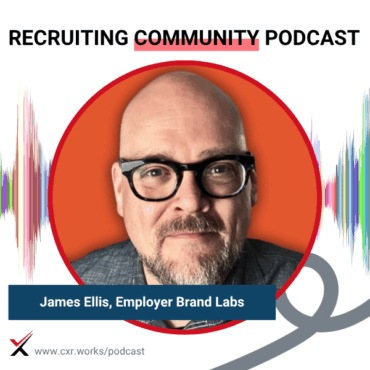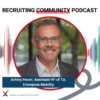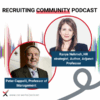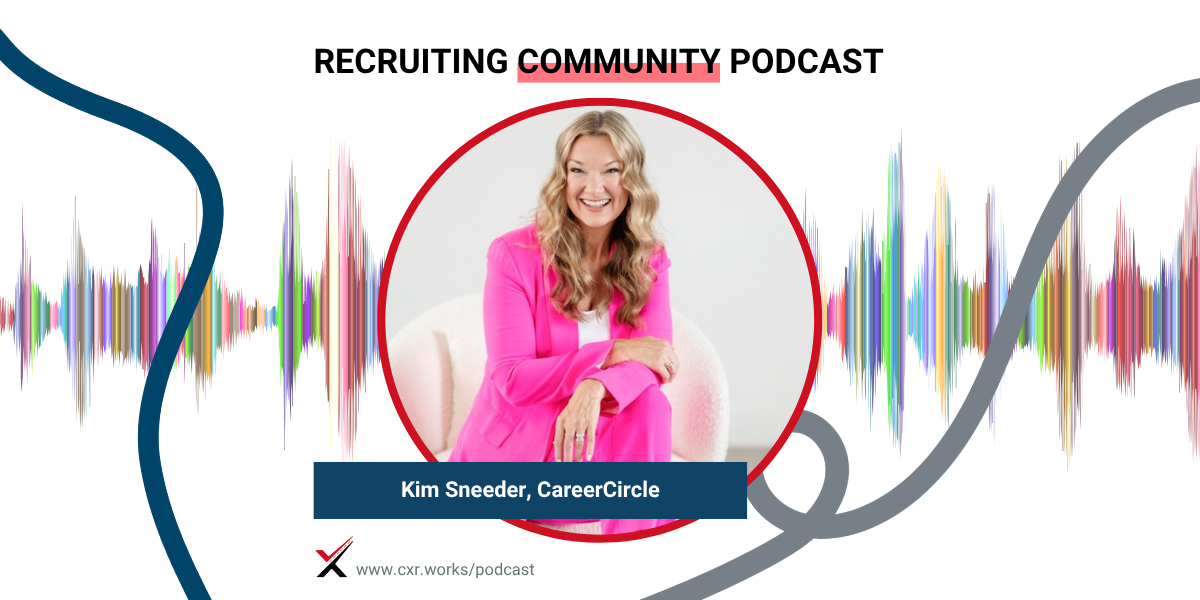
The Value of a Strong Employer Brand (and a few other things…)
Is employer branding evolving—or just getting diluted? James Ellis breaks down what works, what’s broken, and how to reclaim value in the creator economy.
 play_arrow
play_arrow
 play_arrow
play_arrow
Transforming High-Volume Hiring at 7-Eleven Cami Grace
 play_arrow
play_arrow
From Early Childhood to Talent Tech: Allyn Bailey’s Career Crossroads Cami Grace
 play_arrow
play_arrow
In Praise of the Office Cami Grace

Episode Overview:
In this episode of the CXR channel, the focus is on bridging the skills gap and fostering opportunities for underserved communities through strategic partnerships and initiatives. Kim Sneeder shares her journey with CareerCircle, emphasizing how targeted efforts in skill development can make a tangible impact.
Key Topics Covered:
Closing Notes:
In closing, this episode highlights the critical need for targeted skill development programs and explores the mechanisms through which businesses can implement these initiatives to foster inclusivity and diversity. Kim Sneeder’s insights provide a roadmap for companies looking to make a substantive difference in the communities they serve while also enriching their own organizational culture and capabilities. As the podcast wraps up, listeners are encouraged to engage with future episodes and contribute to the ongoing conversation about effective talent management and community engagement in the corporate world.
Title:
Closing the Opportunity Divide
Featured Guests:
Kim Sneeder, Managing Director, CareerCircle
Hosts:
Chris Hoyt
Gerry Crispin
Episode Overview:
Kim Sneeder joins the CXR Recruiting Community Podcast to share how CareerCircle connects underserved communities to meaningful career opportunities through upskilling, reskilling, and advocacy. Drawing from 25+ years at Allegis Group and her leadership of CareerCircle, Kim outlines strategies for recruiters and employers to build trust with community partners and create inclusive, skills-based hiring pipelines.
Key Topics:
Engaging community organizations to reach underserved talent
Building trust through transparency and long-term commitment
Aligning internal departments—TA, DEI, L&D—for effective collaboration
Upskilling strategies to close tech and skills gaps
Supporting women and other reentry populations returning to the workforce
Addressing performative vs. results-driven DEI initiatives
Offering rejected candidates development pathways, not dead ends
Notable Quotes:
“You can’t just drop in and say you’re committed; you have to earn it over time.” — Kim Sneeder
“Trust is earned in drops and lost in buckets.” — Chris Hoyt
“Why not say, ‘You’re missing this skill—here’s how to get it’? Build a bridge.” — Kim Sneeder
“We want your community to thrive with us.” — Kim Sneeder
“Moving from Performative Work to Results.” — Kim Sneeder
Takeaways:
Building truly inclusive pipelines requires more than outreach—it demands long-term relationships, honest self-assessment, and a commitment to candidate development. Kim Sneeder and CareerCircle offer a model for how organizations can move from good intentions to measurable impact by focusing on trust, skills-first hiring, and meaningful community partnerships.
Want more conversations like this?
Subscribe to the CXR podcast and explore how top talent leaders are shaping the future of recruiting. Learn more about the CareerXroads community at cxr.works.
Chris Hoyt: So I’m already crying and we’ve just gotten started. We’re having a conversation around life stages—Kim, I don’t know the better way to put it—like, those who in their twenties start knocking out babies and raising them. They’re in their fifties now, and the kids are off the payroll. That’s the scenario I’m in. But Kim, you have a slightly different scenario, right? You waited a little longer.
Kim Sneeder: That’s right. I waited until my forties to start the process. So while my other friends are celebrating their kids’ graduation from college, we’re celebrating graduation from kindergarten.
Gerry Crispin: That’s cool.
Chris Hoyt: Yeah. But no one has a better perspective on some of the life stages—maybe it’s because he’s been around a little while—than Jerry. Jerry, you have an opinion on grandparenting versus parenting?
Gerry Crispin: Yes. I’ve always said if I could’ve, I would’ve started with my grandchildren. With your children, there’s that push-pull—you have a responsibility to raise them right, to make them work, and frankly, most parents struggle having confidence in being parents. But someday, when they’re out in the world, working and surviving, you go, “I guess I did a pretty damn good job.”
With your grandchildren though, there’s no pressure. You’re not responsible. You just enjoy them. You can build legacy—or get back at your kids for how they treated you—by spoiling the grandkids. I’m living my best life. I’ve got a 13-year-old and a 15-year-old grandchild, and they’re giving their parents hell. It’s great.
Kim Sneeder: You give me hope, Jerry.
Chris Hoyt: That’s the goal of parenthood: just don’t raise monsters. Raise responsible humans who are proud of how they live and the work they do. That was my only blueprint.
Kim Sneeder: The amount of times in our house you hear, “Just be a good human.” When all else fails, that’s my go-to.
Chris Hoyt: It’s hard. I know this isn’t a parenting podcast, but I’ll share one story. My oldest daughter was helping me fix a stair railing. She picked up tools and asked, “Daddy, what’s this?” I told her, “That’s a screwdriver.” A minute later: “What’s this?” “That’s a hammer.” Then she says, “Daddy… what the hell is this?” I looked down and went, “Where the hell did she learn that?” Sponges. They’re little sponges.
All right, parenting tips aside—are we ready to jump in?
Kim Sneeder: Absolutely.
Gerry Crispin: Yeah.
Chris Hoyt: Here we go.
Announcer: CXR Channel—our premier podcast for talent acquisition and talent management. Listen in as the CXR community discusses a wide range of topics focused on attracting, engaging, and retaining the best talent. We’re glad you’re here.
Chris Hoyt: Welcome, welcome, welcome, everybody. I am your host, Captain Kirk. With me, I have my sidekick, Mr. Spock. How are you, Mr. Spock?
Gerry Crispin: Fabulous, Kirk. You gotta give me a heads up when you’re gonna do this stuff! I bet I could move my ears or something.
Chris Hoyt: Can you do that Vulcan hand thing? There you go! Well done—very logical of you.
Welcome to the Recruiting Community Podcast—weekly insights and conversations. We bring in guests to talk about the work they’re doing, their expertise, and their perspective.
This week we’re joined by Kim Sneeder, Managing Director at CareerCircle. We’re going to talk about connecting underserved communities with career opportunities, building skilled and diverse talent pipelines, and topics like upskilling, reskilling, and bridging the skills gap.
Quick housekeeping: we’re streaming on YouTube, Facebook, LinkedIn, and even Twitch! Believe it or not, we get two or three folks tuning in regularly there. If you’re on LinkedIn, say hello in the chat and ask questions—we may throw your comments up on screen.
This podcast is a labor of love—nobody pays to be on the show. We invite people here because they’ve got something important to say.
Jerry, before we bring in Kim, should we talk about the marketplace?
Gerry Crispin: Yes! We launched the CXR Marketplace last week—six hours of livestreaming with 18 vendors and solutions. It was great.
Chris Hoyt: Yeah, so cxr.works/marketplace—anyone can now sign up, rate, review, or invite vendors. It’s not just for members anymore.
Gerry Crispin: I love that. And I want to see the difference in ratings between member reviews and public reviews—that’ll help us understand different perspectives.
Chris Hoyt: I think we just added that filter—a little tick box so you can choose. Once you’ve rated three or more vendors, additional community features unlock. One thing I love: if someone gives a neutral or negative NPS score, their comments don’t get published. Instead, they’re prompted to provide anonymous, constructive feedback that goes directly to the vendor.
We’re not trying to be Glassdoor. We want a win-win environment.
Gerry Crispin: Agreed. It’s about helping peers understand how to best use a tool or service, and helping vendors improve.
Chris Hoyt: All right. Let’s bring Kim in.
Kim Sneeder: Hello everyone!
Chris Hoyt: Kim, for those who may not know you, give us your elevator pitch—who is Kim Sneeder, and why should we be paying attention?
Kim Sneeder: Thanks, Chris. I’m Kim Sneeder. I’ve been with Allegis Group for 25+ years. About five years ago, I launched CareerCircle. The idea was to address the skills gap—especially with the pace of change in technology—and to serve the communities most impacted.
It’s been my passion project. We’ve partnered with about 150 nonprofits, reaching out to underserved communities, giving them access to skills, and advocating for them to secure employment. It’s incredibly fulfilling—serving the community while solving a complex problem for employers.
Chris Hoyt: I love that. Let’s jump right in. If I’m a recruiter looking to engage underserved communities, what should I be watching for?
Kim Sneeder: First, connect with organizations and community groups that represent underserved populations. It’s about building relationships and trust—there’s a transfer of trust that needs to happen. You can’t just drop in and say you’re committed; you have to earn it over time.
Chris Hoyt: Are there effective upskilling or reskilling strategies to build those pipelines?
Kim Sneeder: It depends. If you’re doing it in-house, engage L&D to identify tech or skill gaps. Are you reacting to the market each time a role is hard to fill? Or are you proactively building a talent pipeline?
You can also partner with bootcamps or training orgs in the specific skills you need. Ideally, you do both.
Chris Hoyt: Do companies struggle internally to get support from other departments for this kind of outreach?
Kim Sneeder: Yes. Ideally, your DEI leader, L&D, TA, and hiring managers are all aligned. But if an organization doesn’t have that infrastructure, it’s hard. That’s what we try to solve—streamlining the approach for employers who want to do the work but don’t know where to start.
Gerry Crispin: That’s a great point. Large companies with deep pockets can invest in scholarships or long-term pipelines. But most companies don’t have that luxury.
Kim Sneeder: Exactly. Even just engaging nonprofits takes time. You can’t call and say, “We want to hire diverse candidates.” You have to show them your data, your leadership diversity, your commitment. If you’re just starting out, be honest. Say, “We’re at the beginning, and we want you to be part of our journey.”
Chris Hoyt: That resonates. The CXR Foundation has experienced that—reaching out to partner with community orgs hasn’t been as easy as I thought. I love that quote: “Trust is earned in drops and lost in buckets.” So what’s your tip for TA leaders who are ready to establish these relationships?
Kim Sneeder: Honesty. If your org is strong on DEI, lead with your data. If you’re not there yet, be transparent and explain your plan. Say, “Here’s what we’re doing, and we want your community to thrive with us.”
Gerry Crispin: I hadn’t thought about the issue of women reentering the workforce after time off—but it’s huge. Many don’t go back into STEM roles because they feel outdated. We need ways to help them stay current or regain those skills.
Kim Sneeder: Spot on. And think about the message when someone applies and gets rejected for missing just one skill—they start to believe they’re not qualified. Why end the conversation there? Why not say, “You’re missing this skill—here’s how to get it”? Build a bridge.
Chris Hoyt: Kim, if you were going to write a book on this topic, what would the title be?
Kim Sneeder: Moving from Performative Work to Results.
Chris Hoyt: I love that. And who gets the first signed copy?
Kim Sneeder: Andy Hilger, former president of Allegis Group. He hired me based on my skills—not my resume. He gave me the opportunity to do this work. A lot of my passion comes from wanting to give others that same opportunity.
Chris Hoyt: What a beautiful note to end on. For those listening, we’re off next week but will be back soon. Visit cxr.works/podcast to catch past episodes and see what’s coming up. If you’d like to be a guest, reach out!
Kim, stay on—don’t go anywhere. I’ve got an idea.
Kim Sneeder: Sounds great. Thank you.
Announcer: Thanks for listening to the CXR Channel. Please subscribe to CXR on your favorite podcast platform and leave us a review. Learn more at cxr.works and follow us on social @careerxroads. Catch you next time.
Tagged as: DEI, upskilling, Podcast.
Chris Hoyt is the President of CareerXroads, a global peer community for talent acquisition leaders driving strategic change. With decades of experience leading recruiting innovation at Fortune 500 companies, Chris now advises enterprise TA teams on tech, process, and leadership. He’s a frequent speaker at conferences like SHRM, HR Tech, LinkedIn, and UNLEASH, and he’s known for pushing conversations beyond buzzwords to get to what really works in hiring. Through CXR, he connects top TA professionals to solve real problems, challenge norms, and shape the future of recruiting.

Is employer branding evolving—or just getting diluted? James Ellis breaks down what works, what’s broken, and how to reclaim value in the creator economy.